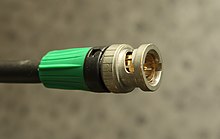
Back Serial Digital Interface Catalan Serial digital interface Czech Serial Digital Interface German Interfaz Digital Serial Spanish Serial digital interface French Serial Digital Interface Italian シリアルデジタルインタフェース Japanese 시리얼 디지털 인터페이스 Korean Serial digital interface Polish Serial Digital Interface Portuguese
This article needs additional citations for verification. (September 2008) |
| Serial digital interface | |
 Serial digital interface uses BNC connectors | |
| Abbreviation | SDI / SD-SDI / HD-SDI / SDI 3G / SDI 6G / SDI 12G |
|---|---|
| Status | Active |
| Year started | 1989 |
| Latest version | 12G 2015 |
| Organization | SMPTE (The Society of Motion Picture and Television Engineers) |
| Predecessor | CVBS - Composite Video |
Serial digital interface (SDI) is a family of digital video interfaces first standardized by SMPTE (The Society of Motion Picture and Television Engineers) in 1989.[1][2] For example, ITU-R BT.656 and SMPTE 259M define digital video interfaces used for broadcast-grade video. A related standard, known as high-definition serial digital interface (HD-SDI), is standardized in SMPTE 292M; this provides a nominal data rate of 1.485 Gbit/s.[3]
Additional SDI standards have been introduced to support increasing video resolutions (HD, UHD and beyond), frame rates, stereoscopic (3D) video,[4][5] and color depth.[6] Dual link HD-SDI consists of a pair of SMPTE 292M links, standardized by SMPTE 372M in 1998;[2] this provides a nominal 2.970 Gbit/s interface used in applications (such as digital cinema or HDTV 1080P) that require greater fidelity and resolution than standard HDTV can provide. 3G-SDI (standardized in SMPTE 424M) consists of a single 2.970 Gbit/s serial link that allows replacing dual link HD-SDI. 6G-SDI and 12G-SDI standards were published on March 19, 2015.[7][8]
These standards are used for transmission of uncompressed, unencrypted digital video signals (optionally including embedded audio and time code) within television facilities; they can also be used for packetized data. SDI is used to connect together different pieces of equipment such as recorders, monitors, PCs and vision mixers. Coaxial variants of the specification range in length but are typically less than 300 meters (980 ft). Fiber optic variants of the specification such as 297M allow for long-distance transmission limited only by maximum fiber length or repeaters.
SDI and HD-SDI are usually available only in professional video equipment because various licensing agreements restrict the use of unencrypted digital interfaces, such as SDI, prohibiting their use in consumer equipment. Several professional video and HD-video capable DSLR cameras and all uncompressed video capable consumer cameras use the HDMI interface, often called clean HDMI. There are various mod kits for existing DVD players and other devices such as splitters that ignore HDCP, which allow a user to add a serial digital interface to these devices.[citation needed]
- ^ Charles A. Poynton (2003). Digital Video and HDTV. Morgan Kaufmann. ISBN 978-1-55860-792-7.
- ^ a b John Hudson (2013). "3Gb/s SDI for Transport of 1080p50/60, 3D, UHDTV1 / 4k and Beyond" (PDF). Archived from the original (PDF) on 2016-03-04. Retrieved 2014-03-13.
- ^ Francis Rumsey, John Watkinson (2004). Digital interface handbook. Taylor & Francis. ISBN 9780240519098.
- ^ "AJA Introduces Hi5-3D Mini-Converter For Stereo 3D Monitoring by Scott Gentry – ProVideo Coalition". 10 September 2010.
- ^ "Archived copy" (PDF). Archived from the original (PDF) on 2021-05-08.
{{cite web}}: CS1 maint: archived copy as title (link) - ^ Signalling and Transport of HDR and Wide Colour Gamut Video over 3G-SDI Interfaces. May 23, 2020 – via tech.ebu.ch.
- ^ ST 2081-10:2015 – 2160-Line and 1080-Line Source Image and Ancillary Data Mapping for Single-Link 6G-SDI. IEEE. 2015-03-19. doi:10.5594/SMPTE.ST2081-10.2015. ISBN 978-1-61482-857-0.
- ^ ST 2082-10:2015 - 2160-line Source Image and Ancillary Data Mapping for 12G-SDI. IEEE. 2015-03-19. doi:10.5594/SMPTE.ST2082-10.2015. ISBN 978-1-61482-860-0.